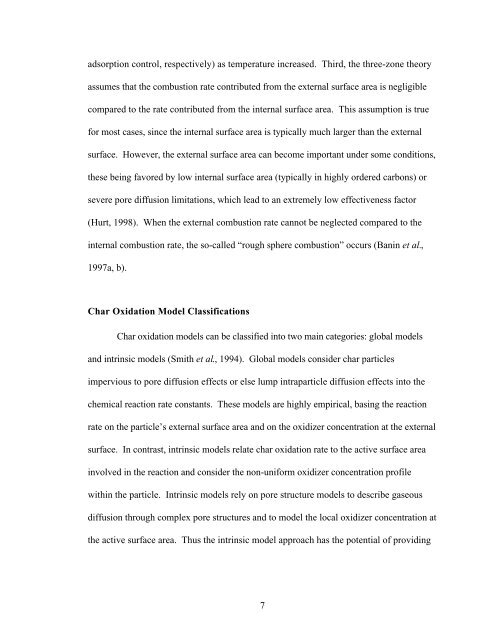MODELING CHAR OXIDATION AS A FUNCTION OF PRESSURE ...
MODELING CHAR OXIDATION AS A FUNCTION OF PRESSURE ...
MODELING CHAR OXIDATION AS A FUNCTION OF PRESSURE ...
Create successful ePaper yourself
Turn your PDF publications into a flip-book with our unique Google optimized e-Paper software.
adsorption control, respectively) as temperature increased. Third, the three-zone theory<br />
assumes that the combustion rate contributed from the external surface area is negligible<br />
compared to the rate contributed from the internal surface area. This assumption is true<br />
for most cases, since the internal surface area is typically much larger than the external<br />
surface. However, the external surface area can become important under some conditions,<br />
these being favored by low internal surface area (typically in highly ordered carbons) or<br />
severe pore diffusion limitations, which lead to an extremely low effectiveness factor<br />
(Hurt, 1998). When the external combustion rate cannot be neglected compared to the<br />
internal combustion rate, the so-called “rough sphere combustion” occurs (Banin et al.,<br />
1997a, b).<br />
Char Oxidation Model Classifications<br />
Char oxidation models can be classified into two main categories: global models<br />
and intrinsic models (Smith et al., 1994). Global models consider char particles<br />
impervious to pore diffusion effects or else lump intraparticle diffusion effects into the<br />
chemical reaction rate constants. These models are highly empirical, basing the reaction<br />
rate on the particle’s external surface area and on the oxidizer concentration at the external<br />
surface. In contrast, intrinsic models relate char oxidation rate to the active surface area<br />
involved in the reaction and consider the non-uniform oxidizer concentration profile<br />
within the particle. Intrinsic models rely on pore structure models to describe gaseous<br />
diffusion through complex pore structures and to model the local oxidizer concentration at<br />
the active surface area. Thus the intrinsic model approach has the potential of providing<br />
7
















